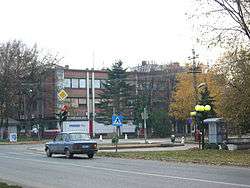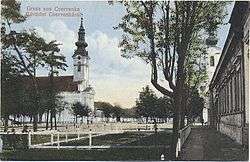Crvenka
| Crvenka Црвенка/Crvenka | |
|---|---|
| Village | |
| Crvenka | |
 | |
| Coordinates: 45°39′30″N 19°27′20″E / 45.65833°N 19.45556°ECoordinates: 45°39′30″N 19°27′20″E / 45.65833°N 19.45556°E | |
| Country | Serbia |
| Province | Vojvodina |
| District | West Bačka District |
| Municipalities | Kula municipality |
| Establishment | Inhabited during the early Neolithic |
| Government | |
| • Mayor | Dragan Pavićević |
| Elevation | 86 m (282 ft) |
| Population | |
| • Total |
|
| • Density | 142/km2 (370/sq mi) |
| Time zone | CET (UTC+1) |
| • Summer (DST) | CEST (UTC+2) |
| Postal code | 25220 |
| Area code(s) | (+381) 25 |
| Car plates | SO |




Crvenka (Serbian Cyrillic: Црвенка) is a small town located in the Kula municipality, in the West Bačka District, Autonomous Province of Vojvodina, Serbia. The town has a Serb ethnic majority and its population numbered 9,001 people in 2011.
Name
In Serbian, the town is known as Црвенка or Crvenka, in Hungarian as Cservenka, and in German as Tscherwenka or Rotweil. The name of the town derived from the Serbian word "crveno" ("red" in English).
History
The region around Crvenka was during its prehistory era long time covered by water, because between the Danube river and Telečka Plateau was a large lake, which was described by Roman historians as Sweet Lake. At that time it was possible to travel by boat till the Fruška Gora mountains. In the city they found remains of prehistoric animals such as the mammoth. The region was most likely inhabited during the early Neolithic when the region belonged to the Starčevo culture. Later the Celts were settled in the area around Crvenka.
It was found archaeological excavations in the immediate vicinity of objects from the Celtic and Roman times, including urns, pottery, as well as Celtic and Roman coins. On the Roman coins, the so-called Follis, the Roman Emperor Constantine the Great was depicted, and some others originated from the Republic of Venice. From the middle of the 1st century to the 4th century, the region belonged to the dominion of the Iazyges, a nomadic tribe which belonged to the Sarmatians. From the 5th century Slavs settled in the region and from the 9th century also Finno-Ugric people.
Crvenka was firstly mentioned in the 16th century, during Ottoman administration. It was populated by ethnic Serbs and was part of the Sanjak of Segedin and of the Budin Eyalet. In the second half of the 17th century, this area was not populated.
In the end of the 17th century, the region of Bačka was captured by the Habsburg Monarchy and in the second half of the 18th century Crvenka was mentioned as a small settlement. It was colonized by Serbs, Hungarians and Germans. Until the middle of the 19th century, the town was part of the Bačko-bodroška County within the Habsburg Kingdom of Hungary. In 1848-1849 it was part of the autonomous Serbian Vojvodina and from 1849 to 1860 it was part of the Voivodeship of Serbia and Banat of Temeschwar, a separate Habsburg crownland. After abolishment of the voivodeship in 1860, the town was again included into Bačko-bodroška County. According to 1910 census, most of the inhabitants of the town spoke German language.
Since 1918, the town was part of the Kingdom of Serbs, Croats and Slovenes (later renamed to Yugoslavia). In 1918-1919, it was part of the Banat, Bačka and Baranja region, and also (from 1918 to 1922) part of the Novi Sad County. From 1922 to 1929, it was part of the Bačka Oblast, and from 1929 to 1941 part of the Danube Banovina.
From 1941 to 1944, Crvenka was under Axis occupation and was attached to the Horthy's Hungary. In 1944, the Soviet Red Army and Yugoslav partisans liberated Crvenka and it was included into autonomous province of Vojvodina within new socialist Yugoslavia. Since 1945, Vojvodina is part of the People's Republic of Serbia within Yugoslavia. In the end of the World War II, Germans left from Crvenka, which was then populated by 4,383 people, mostly Serbs of Bosnia and Herzegovina and Montenegro. In 1948, these people comprised 63.7% of population.
Demographics
Ethnic groups
In 2002 the population of Crvenka was 10,163 people, including:
- Serbs = 7,264 (71.48%)
- Montenegrins = 1,313 (12.92%)
- Hungarians = 493 (4.85%)
- Croats = 183 (1.8%)
- Yugoslavs = 156 (1.54%)
- others (including Ukrainians, Pannonian Rusyns, Germans, Romani people, etc.)
Historical population
- 1948: 6,879
- 1953: 7,797
- 1961: 9,369
- 1971: 10,098
- 1981: 10,629
- 1991: 10,409
- 2002: 10,315
- 2011: 9,001
Politics
There is an initiative among inhabitants of Crvenka that this settlement should become its own municipality.
Economy
Crvenka is a small town with a very strong economy, especially industry and agriculture.
Here is a list of the most important companies from Crvenka:
- Sugar Factory Crvenka (Crvenka Fabrika Šećera a.d. / EBZ)[1]
- The Jaffa Biscuit Company[2]
- Alcohol and Beverage Factory Panon AD[3]
- FSH Crvenka AD
- Jedinstvo IGM Crvenka[4]
- SIGMA d.o.o
- ALTER EGO d.o.o[5]
- DP Zaliv d.o.o.[6]
- ZZ Novo
- BXB d.o.o
- Permak d.o.o[7]
Sport
Crvenka has a famous handball club, named RK Crvenka. There is also football team, FK Crvenka, with a long tradition. Crvenka is also well famous by chess club ŠK Miljo Vujović and Karate.
Notable citizens
- Ratko Svilar, former football goalkeeper who participated in the 1982 FIFA World Cup.
- Zorica Vojinović, former handball player who competed in the 1980 Summer Olympics.
See also
Gallery
 Railway
Railway- Railway Station
 Bus Station
Bus Station Town Center
Town Center
Notes
References
- Slobodan Ćurčić, Broj stanovnika Vojvodine, Novi Sad, 1996.
- Slobodan Ćurčić, Naselja Bačke - geografske karakteristike, Novi Sad, 2007.
External links
| Wikimedia Commons has media related to Crvenka. |